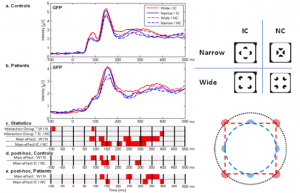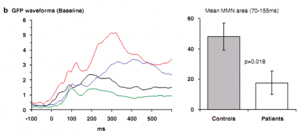Overview
Recent findings show early sensory deficits in chronic schizophrenia population, such as visual P1 deficit (Knebel et al 2011) or auditory MMN deficit. Our new studies aim to determine if such deficits can be used as biomarkers for schizophrenia disease. Early sensory processing is based on low level treatment and is less subject to patient’s variability. Therefore sensory deficits in such processing could be the interesting specific biomarkers. Such biomarkers could help clinicians on early disease detection or early precise diagnosis (schizo affective, schizo paranoid …). To reach this goal it is important to define if these deficits reflect the progression of illness or if they are markers of the disease itself. To answer these questions we are using our sensory deficit experimental paradigm to patients in early phase psychosis (population that reaches psychosis threshold for less than 5 years, but without clear diagnosis), to patients with first episode and to prodroma population.
To specify deficits in early auditory and visual processing in chronic patients I am applying the auditory MMN paradigm using 3 type of deviants (pitch, duration and location) and a paradigm using visual Kanisza figures with 2 different shapes (see image below). In addition, clinical and biological measures were also recorded to determine the link between early deficits and such measures.
To validate the definition of a biomarker for such disease, I am interested in developing a method based on the detection of early sensory deficits that will allow to classify not only patients and control participants in different groups, but also to specify and separate different pathologies.


CollaboratorsDr. Jean-François Knebel,
Prof. Micah Murray,
Prof. Stephanie Clarke
External collaborator
Cery (Under construction..)
Funding
(Under construction..)


